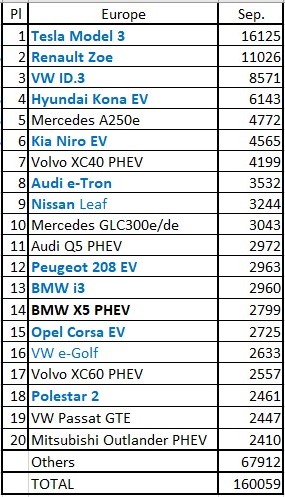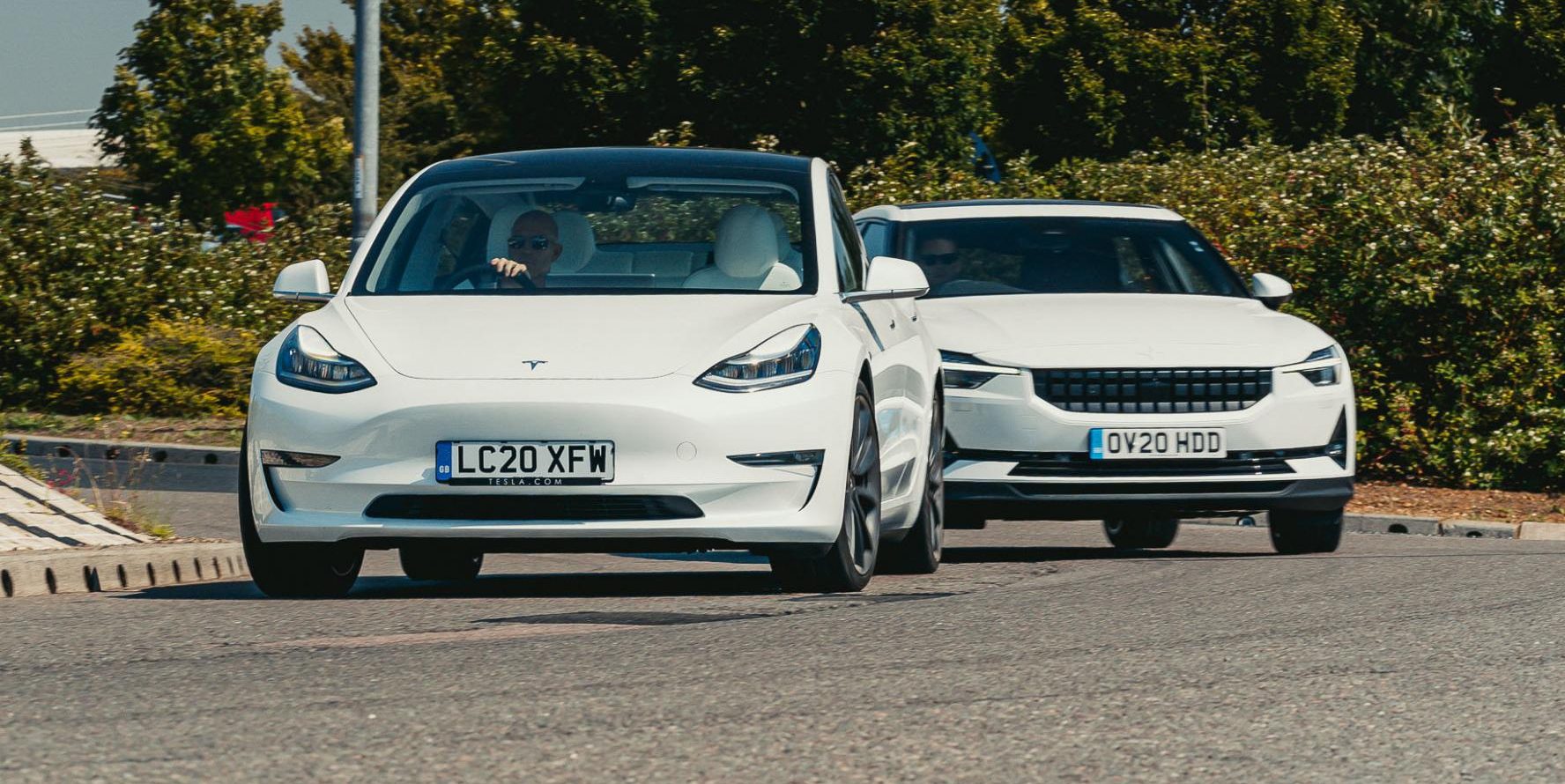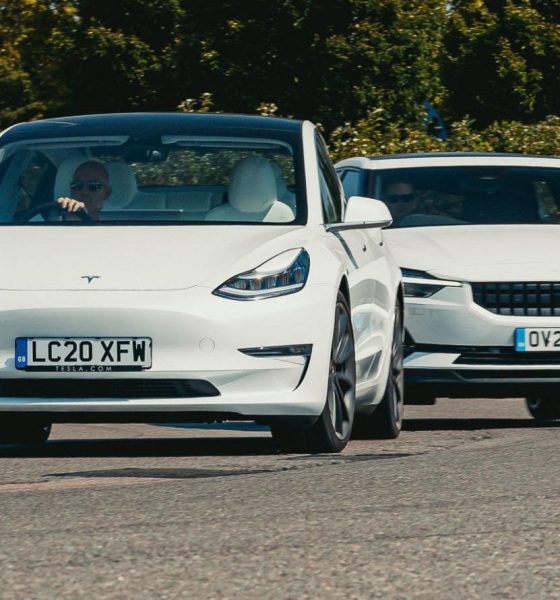Tesla has performed well in September in Europe, new data shows. Despite skeptics and short-sellers of the electric carmaker stating that the company’s performance in the European market has been sub-par, the Model 3 was the best-selling EV in the region. Not only did it land in the top spot, but it had its best month in 2020 in September.
New data from the EV Sales Blog shows the Model 3 returned to form with a new “high-tide” month. 16,125 units of the company’s best-selling sedan were delivered to European customers, with the main points of focus being in the United Kingdom (4,800 units), Germany (2,776 units), Norway (1,116 units, its highest in 2020), and France (1,083 units).
Credit: EV Sales Blog
The surge in sales and deliveries shows that Tesla’s performance in arguably the most competitive EV market is far from weak. Despite numerous German automakers holding some of the most popular EV names, like Germany’s Volkswagen with the ID.3 and France’s Renault Zoe, the Model 3 maintained its popularity through industry-leading range and battery tech.
The Zoe finished September in second-place with 11,026 units and the VW ID.3 in third with 8,571 cars.
All of the 16,125 Model 3s that made their way to new owners were manufactured at Tesla’s Fremont production plant in Northern California. However, some of the October and November deliveries will come from Tesla’s Giga Shanghai plant in China, which will supply the continent with all-electric sedans in the coming months. For demand to be fed, Tesla required some help with exporting China-made Model 3s to Europe. A previously unwanted strategy, the shipment of 7,000 Model 3 units made their way from China to Europe earlier this week.
Tesla China holds ceremony to commemorate first 7K Model 3 exports to Europe
Interestingly, some bearish analysts have seen this as a move to keep the rumor of falling Chinese demand under wraps. However, the Model 3 continues to be delivered to over 10,000 people every month in China. Most recent figures show 11,329 units of the affordable sedan were delivered to owners in China in September.
The idea that Tesla is getting beat in the European market by domestic automakers is simply untrue. The Model 3 still sits in second place behind the Renault Zoe for Year-to-Date rankings with 57,167 cars sold, making up for 7% of the total EV market share on the continent. However, Tesla is sure to regain the first-place spot in 2021 after the Model Y begins its initial deliveries from builds at the new Giga Berlin facility. With the company’s first European production plant poised for an opening shortly, some owners have reported that Tesla has already contacted them to prepare for deliveries in Q1 or Q2 2021.
As shorts and bearish analysts continue to portray Tesla’s performance in Europe as a weak point, the company shows no signs of slowing down in the market. A strong September shows there is more than enough demand in the continent as citizens quench their thirst for the best all-electric cars on the market today.

News
Tesla starts showing how FSD will change lives in Europe
Local officials tested the system on narrow country roads and were impressed by FSD’s smooth, human-like driving, with some calling the service a game-changer for everyday life in areas that are far from urban centers.

Tesla has launched Europe’s first public shuttle service using Full Self-Driving (Supervised) in the rural Eifelkreis Bitburg-Prüm region of Germany, demonstrating how the technology can restore independence and mobility for people who struggle with limited transport options.
Local officials tested the system on narrow country roads and were impressed by FSD’s smooth, human-like driving, with some calling the service a game-changer for everyday life in areas that are far from urban centers.
Officials see real impact on rural residents
Arzfeld Mayor Johannes Kuhl and District Administrator Andreas Kruppert personally tested the Tesla shuttle service. This allowed them to see just how well FSD navigated winding lanes and rural roads confidently. Kruppert said, “Autonomous driving sounds like science fiction to many, but we simply see here that it works totally well in rural regions too.” Kuhl, for his part, also noted that FSD “feels like a very experienced driver.”
The pilot complements the area’s “Citizen Bus” program, which provides on-demand rides for elderly residents who can no longer drive themselves. Tesla Europe shared a video of a demonstration of the service, highlighting how FSD gives people their freedom back, even in places where public transport is not as prevalent.
What the Ministry for Economic Affairs and Transport says
Rhineland-Palatinate’s Minister Daniela Schmitt supported the project, praising the collaboration that made this “first of its kind in Europe” possible. As per the ministry, the rural rollout for the service shows FSD’s potential beyond major cities, and it delivers tangible benefits like grocery runs, doctor visits, and social connections for isolated residents.
“Reliable and flexible mobility is especially vital in rural areas. With the launch of a shuttle service using self-driving vehicles (FSD supervised) by Tesla in the Eifelkreis Bitburg-Prüm, an innovative pilot project is now getting underway that complements local community bus services. It is the first project of its kind in Europe.
“The result is a real gain for rural mobility: greater accessibility, more flexibility and tangible benefits for everyday life. A strong signal for innovation, cooperation and future-oriented mobility beyond urban centers,” the ministry wrote in a LinkedIn post.
News
Tesla China quietly posts Robotaxi-related job listing
Tesla China is currently seeking a Low Voltage Electrical Engineer to work on circuit board design for the company’s autonomous vehicles.

Tesla has posted a new job listing in Shanghai explicitly tied to its Robotaxi program, fueling speculation that the company is preparing to launch its dedicated autonomous ride-hailing service in China.
As noted in the listing, Tesla China is currently seeking a Low Voltage Electrical Engineer to work on circuit board design for the company’s autonomous vehicles.
Robotaxi-specific role
The listing, which was shared on social media platform X by industry watcher @tslaming, suggested that Tesla China is looking to fill the role urgently. The job listing itself specifically mentions that the person hired for the role will be working on the Low Voltage Hardware team, which would design the circuit boards that would serve as the nervous system of the Robotaxi.
Key tasks for the role, as indicated in the job listing, include collaboration with PCB layout, firmware, mechanical, program management, and validation teams, among other responsibilities. The role is based in Shanghai.
China Robotaxi launch
China represents a massive potential market for robotaxis, with its dense urban centers and supportive policies in select cities. Tesla has limited permission to roll out FSD in the country, though despite this, its vehicles have been hailed as among the best in the market when it comes to autonomous features. So far, at least, it appears that China supports Tesla’s FSD and Robotaxi rollout.
This was hinted at in November, when Tesla brought the Cybercab to the 8th China International Import Expo (CIIE) in Shanghai, marking the first time that the autonomous two-seater was brought to the Asia-Pacific region. The vehicle, despite not having a release date in China, received a significant amount of interest among the event’s attendees.
Elon Musk
Elon Musk and Tesla AI Director share insights after empty driver seat Robotaxi rides
The executives’ unoccupied tests hint at the rapid progress of Tesla’s unsupervised Robotaxi efforts.

Tesla CEO Elon Musk and AI Director Ashok Elluswamy celebrated Christmas Eve by sharing personal experiences with Robotaxi vehicles that had no safety monitor or occupant in the driver’s seat. Musk described the system’s “perfect driving” around Austin, while Elluswamy posted video from the back seat, calling it “an amazing experience.”
The executives’ unoccupied tests hint at the rapid progress of Tesla’s unsupervised Robotaxi efforts.
Elon and Ashok’s firsthand Robotaxi insights
Prior to Musk and the Tesla AI Director’s posts, sightings of unmanned Teslas navigating public roads were widely shared on social media. One such vehicle was spotted in Austin, Texas, which Elon Musk acknowleged by stating that “Testing is underway with no occupants in the car.”
Based on his Christmas Eve post, Musk seemed to have tested an unmanned Tesla himself. “A Tesla with no safety monitor in the car and me sitting in the passenger seat took me all around Austin on Sunday with perfect driving,” Musk wrote in his post.
Elluswamy responded with a 2-minute video showing himself in the rear of an unmanned Tesla. The video featured the vehicle’s empty front seats, as well as its smooth handling through real-world traffic. He captioned his video with the words, “It’s an amazing experience!”
Towards Unsupervised operations
During an xAI Hackathon earlier this month, Elon Musk mentioned that Tesla owed be removing Safety Monitors from its Robotaxis in Austin in just three weeks. “Unsupervised is pretty much solved at this point. So there will be Tesla Robotaxis operating in Austin with no one in them. Not even anyone in the passenger seat in about three weeks,” he said. Musk echoed similar estimates at the 2025 Annual Shareholder Meeting and the Q3 2025 earnings call.
Considering the insights that were posted Musk and Elluswamy, it does appear that Tesla is working hard towards operating its Robotaxis with no safety monitors. This is quite impressive considering that the service was launched just earlier this year.










